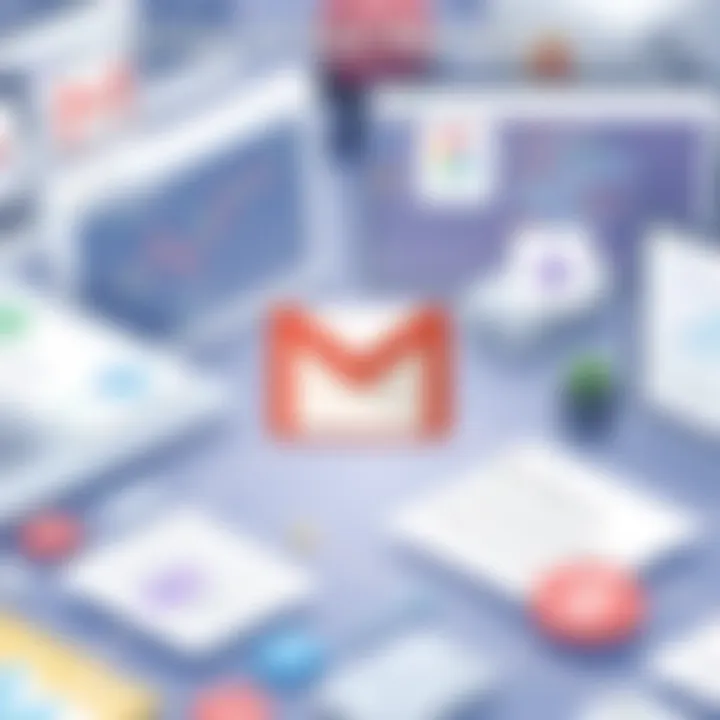Cost Analysis of Gmail Suite: Pricing and Features


Intro
In the age of digital communication, the tools we use to connect and collaborate have never been more crucial. One of the most prominent players in this landscape is Gmail Suite, a comprehensive set of tools that caters to both individual users and businesses alike. With its roots firmly planted in the widely-used Gmail interface, the Suite branches out into various applications that enhance productivity and streamline workflows.
Understanding the cost associated with Gmail Suite is essential for anyone considering adopting this platform. As users navigate through different plans and features, they may find themselves pondering which options best suit their needs. Additionally, the evolving landscape of software tools dictates that individuals must remain informed about current trends and foreseeable changes within the software ecosystem.
This guide delves into the specific details of Gmail Suite’s pricing structure, highlighting the plans available, the features they include, and how these can be aligned with different requirements and budgets. The analysis not only sheds light on Gmail Suite but also discusses alternatives, ensuring a well-rounded understanding of the costs involved and the value offered.
By the end of this discussion, you will gain a clearer perspective on Gmail Suite's cost implications, allowing for more strategic decision-making that aligns with both personal and professional objectives.
Overview of Gmail Suite
Understanding the Gmail Suite provides valuable insight into how it can enhance individual and organizational productivity. This suite is more than just an email platform; it's a robust set of tools geared towards collaboration and efficiency. Many businesses and professionals rely on Gmail Suite not just for sending emails, but also for managing tasks, sharing files, and communicating effectively.
The importance of this overview cannot be understated. By grasping the fundamental aspects of Gmail Suite, you set the groundwork for exploring its pricing, features, and how it aligns with various needs. So let’s break down the key elements that make this suite a compelling choice in today’s digital workspace.
Definition and Purpose
At its core, the Gmail Suite, now commonly referred to as Google Workspace, is a cloud-based platform designed for streamlined communication and collaboration. It combines Gmail’s email functionality with other productivity tools like Google Drive, Google Docs, and Calendar. The primary purpose is to provide a comprehensive ecosystem where users can not only send emails but also create documents, store files, and work as a team irrespective of geographical barriers.
Adopting Gmail Suite means adopting a suite of interconnected tools that improve workflows and allow for real-time collaboration, making it an attractive prospect for many tech-savvy individuals and business professionals.
Key Features
The Gmail Suite is packed with features that cater to different aspects of a professional environment. Let’s explore some of the standout functionalities:
Email Functionality
Email is, of course, the cornerstone of any email suite. Gmail's email functionality stands out due to its seamless interface and powerful organizational tools. Users benefit from advanced spam filtering, labels, and powerful search capabilities that save time and help maintain order in a bustling inbox.
Additionally, Gmail integrates with other apps, allowing users to add tasks or calendar events right from the email interface. This integration facilitates a smoother workflow, making it a popular choice for busy professionals.
Collaboration Tools
Collaboration tools like Google Docs and Google Meet are integrated effectively within the Gmail Suite. Document sharing and real-time editing capabilities address the needs of teams working remotely or in the office. With features like comments and suggestions, team members can provide feedback instantly, thus nurturing a collaborative environment.
The accessibility of these tools from any device adds to its benefits; whether in a meeting or working on-the-go, users can stay connected and productive,
Cloud Storage
Cloud storage is another significant feature that sets the Gmail Suite apart from purely email-focused solutions. Google Drive allows users to store documents, spreadsheets, and presentations securely online. This capability means that essential files are readily accessible anytime and anywhere as long as there’s internet connectivity.
Moreover, the ability to share these files with specific users or groups promotes teamwork while keeping clarity in collaboration. However, it’s important to note that while the initial storage offered is adequate, organizations requiring extensive storage will need to consider additional costs.
The combination of these features solidifies Gmail Suite's position as a comprehensive platform tailored to enhance productivity and collaboration in a professional landscape.
Pricing Tiers of Gmail Suite
Understanding the Pricing Tiers of Gmail Suite is crucial for making an informed decision about this powerful tool. The various plans cater to different user needs, whether for a small startup or a large corporation. It's not merely about the dollar signs; the value each tier provides can greatly impact productivity and efficiency. By analyzing the specific tier options, businesses can align their technological needs with their budget constraints. Let's break down the offerings.
Basic Plan
Features Included
The Basic Plan is an entry-level option designed to cover essential functionalities suitable for individual users and smaller teams. This plan includes core tools such as Gmail, Drive, and Calendar, enabling seamless communication and organization. One standout feature is the 30GB of cloud storage, which is adequate for basic usage without breaking the bank.


Many users might find this plan appealing due to its straightforward nature and affordability. The ease of setup and maintenance allows users to dive right into their work without spending too much time on configurations or learning curves.
However, a downside to consider is that the features may feel limiting as the demands of a business grow. For instance, the absence of advanced collaboration tools could hinder teamwork for a more expansive initiative.
Cost Analysis
The cost analysis of the Basic Plan reveals competitive pricing, often seen as a first step into the world of productivity tools. Priced attractively, this plan often draws in those who are cost-conscious but require robust functionality. Importantly, though it may require a modest monthly investment, it serves as a gateway for businesses just starting.
However, as with every offering, one must weigh the trade-offs. While it serves basic needs well, companies anticipating rapid growth should be wary of the storage limits and lack of robust week editing tools as their reliance on collaborative projects increases.
Business Plan
Features Included
Stepping up to the Business Plan introduces a range of features tailored for medium-sized companies looking for more than just the basics. This plan includes everything in the Basic Plan but adds tools that ramp up productivity, such as unlimited storage, advanced admin controls, and enhanced security features including access to Google Vault for archiving and eDiscovery.
This makes it a solid choice for businesses that prioritize data integrity and security, allowing organizations to operate with confidence. Nonetheless, this suite of features does require time to learn and fully utilize, which can be a barrier for some.
Cost Analysis
In terms of cost analysis, while the Business Plan accounts for a larger monthly fee than the Basic Plan, the return on investment can be substantial. Companies can integrate various functionalities into one cohesive platform. The clear focus on collaboration in this tier aids in enhanced operational efficiencies.
Additionally, it's vital to consider that pricing might be offset by reduced costs associated with using multiple tools, leading to potential overall savings over time. Still, for companies with fewer immediate needs, this investment might feel like jumping into the deep end.
Enterprise Plan
Features Included
The Enterprise Plan represents the pinnacle of Gmail Suite offerings—perfect for large organizations with diverse needs. Not only does it encompass all previous features, but it also provides enhanced capabilities like advanced security settings and custom cloud solutions to meet unique corporate requirements.
Moreover, one significant aspect is the Data Loss Prevention (DLP) feature, crucial for enterprises dealing with sensitive information. Users also benefit from superior support and service level agreements that cater to their larger operational scale.
However, this extensive feature set comes with complexity. Organizations need to ensure they have the resources to utilize and manage these advanced tools effectively.
Cost Analysis
From a cost analysis perspective, the Enterprise Plan does demand a hefty investment. It tends to be the most expensive tier, but it aligns with the complexities and scale of needs in large organizations. While the upfront cost might seem daunting, the comprehensive features included could effectively reduce long-term costs associated with data breaches or inefficiencies in workflow management.
When evaluating its worth, organizations must consider their size, scope, and whether they can fully leverage the advanced features without overspending on unnecessary tools.
Factors Influencing Cost
Understanding the costs associated with the Gmail Suite is not just about looking at the price tags on the various plans. Several influential factors can make a significant impact on the total cost for individuals and businesses alike. Through examining these elements, you can tailor your Gmail Suite experience to better fit your needs, ensuring you’re not just spending, but investing wisely in a tool that can enhance productivity and communication.
Number of Users
The first aspect to consider is the number of users. The cost of the Gmail Suite is structured around a per-user model, which means as your team grows, so does your investment. For a small business with a handful of employees, this might seem manageable. Yet, if you're scaling up to a medium or larger-sized operation, these costs can escalate quickly.
For instance, if you have a team of 10 people on the Basic Plan, you could end up paying a couple of hundred bucks each month. But bump that team up to 50 employees on the Business Plan, and suddenly you're looking at a bill that could reach into the thousands. The trick here is to predict your growth accurately. Evaluating how many employees you’ll likely need long-term versus how many you have now is crucial for justifying costs effectively.
Volume of Storage Required
Next on the docket is storage volume. Each Gmail Suite plan comes with a certain limit on cloud storage space. The Basic plan offers a modest 30GB per user, whereas the Business and Enterprise plans provide considerably more. If you anticipate needing more storage—beyond simple emails and documents—you might need to factor in the higher-tier plans or even extra storage as a paid add-on.
For example, if your business relies heavily on heavy files like graphics, videos, or extensive datasets, the standard storage limits might not cut it. Going over that limit can result in additional charges, and who wants to be paying unexpected fees? A careful review of the types of files your team handles can lead to substantial savings. You don’t need to pay extra for something you might not even utilize, after all.


Additional Features and Add-ons
Lastly, let’s dissect additional features and add-ons. Gmail Suite offers various functionalities beyond the basic set of tools. From advanced security features to enhanced meeting scheduling and collaboration features, every extra capability could bump up the cost. Not all businesses need the same features—some might benefit from Google Vault for enhanced data management, while others might not.
While many businesses find value in these add-ons, it’s essential to weigh the specific needs against their costs. Consider compiling a list of must-haves versus nice-to-haves in terms of features. This type of analysis helps clarify whether the investment will pay off in increased efficiency or if you might be subscribing to something you won’t fully utilize.
"A smart decision on software choices happens when the needs are clearly outlined and the costs are forecasts are rooted in those needs."
End
By dissecting these factors influencing cost—number of users, storage volume, and additional features—you arm yourself with the knowledge needed to make pragmatic decisions regarding the Gmail Suite. Understanding these elements thoroughly will not only help you navigate the costs effectively but also align your investments with your business strategies and welcome growth.
Comparative Analysis with Competitors
Understanding how Gmail Suite stacks up against its competitors is essential for organizations making informed decisions about their collaboration and productivity tools. An effective comparative analysis provides clarity on the unique selling propositions of each service, the strengths and weaknesses of their offerings, and the overall value they provide relative to their cost. This section aims to dissect how Gmail Suite correlates with Microsoft 365 and Zoho Mail, focusing on key aspects such as features, pricing, usability, and overall performance in the workplace.
Google Workspace vs. Microsoft
When we pit Google Workspace against Microsoft 365, the debate doesn't just boil down to features and cost, but rather the way these tools integrate into daily business operations.
Features and Functionality
- Collaboration Tools: Google Workspace benefits from real-time collaboration, allowing multiple users to work on documents simultaneously through Google Docs, Sheets, and Slides. On the other hand, Microsoft 365 offers a similar suite but is often seen as more robust due to its advanced formatting options and functionalities like Excel’s powerful data analysis tools.
- Email Services: Gmail has the edge with its intuitive layout and advanced filtering options, while Outlook provides exceptional integration with the Windows operating system.
- Cloud Storage: Both platforms offer generous cloud storage capacities, but Google Drive tends to provide seamless integration with other Google services, whereas OneDrive is deeply embedded within the Windows ecosystem.
Pricing Structure
The pricing tends to vary depending on what businesses require. Google Workspace starts at a lower price point, appealing especially to startups and small enterprises. Microsoft 365, while more expensive, potentially offers greater value for larger organizations requiring complex functionalities and security measures.
"Choosing between these services should reflect the working style of the team and the specific operational needs that drive productivity."
Google Workspace vs. Zoho Mail
When looking at Google Workspace in relation to Zoho Mail, it becomes pivotal to focus on how they align with smaller businesses and individual professionals.
User Interface and Ease of Use
- Zoho Mail is known for its clean interface that’s approachable, especially for users new to email services. Meanwhile, Google’s user interface is designed with intuitiveness at its core, facilitating quick access to functions that can enhance daily workflows.
- Customization Options: Zoho shines in customizability, allowing businesses to brand their email interfaces. For companies wanting a more personalized touch, this could be a deciding factor.
Features and Integrations
- While Google Workspace provides a wide suite of integrated tools, Zoho Mail offers unique features, particularly for those leaning towards project management and CRM functionalities. Zoho’s suite of applications can be highly compelling for companies that are already utilizing Zoho’s other services.
- Storage and Cost: In terms of pricing, Zoho Mail often stands out due to its lower cost tier that can attract smaller companies, while the storage space is comparable but with some exceptions in the advanced plans.
Return on Investment Considerations
Understanding return on investment (ROI) for the Gmail Suite is critical for individuals and businesses seeking to evaluate the effectiveness of their expenditures. In this section, we will dissect essential elements that influence ROI, helping you to grasp why considering such metrics is indispensable when investing in digital tools like the Gmail Suite.
Efficiency Gains
One of the primary factors contributing to ROI is the efficiency that the Gmail Suite can provide. With a user-friendly interface and seamless integration with other Google services, users can accomplish tasks quicker than with many alternatives. Here are some insights:
- Collaboration Made Simple: Tools like Google Meet and Google Chat allow teams to communicate and share files instantaneously, eliminating wait time. When teams collaborate effectively, projects move faster. Faster project completion often leads to higher productivity and profitability.
- Automation Features: Gmail provides automated sorting, labeling, and filtering, which help manage what can be a barrage of incoming emails. This feature reduces the amount of time users spend managing their inboxes, freeing up valuable hours for other essential tasks.
- Accessibility Anywhere: With its cloud-based nature, users can access their emails and documents from any device with internet connectivity. This flexibility ensures that employees can work remotely without missing a beat, ultimately translating into better work-life balance and less downtime.
"Efficiency isn’t just a buzzword; it’s a game changer in making the most of your return on investment."
Cost Savings through Integration


Another aspect to consider is how the Gmail Suite integrates with various applications—both within the Google ecosystem and beyond. This interconnectedness offers several cost-saving advantages:
- All-in-One Solution: The Gmail Suite is not just an email service; it's a complete productivity suite that includes Google Drive, Google Docs, Sheets, and more. By utilizing these integrated tools, businesses minimize the need for multiple subscriptions, ultimately reducing overall costs.
- Third-Party Integrations: Many businesses utilize specialized tools for accounting, customer relationship management (CRM), and project management. The Gmail Suite allows integration with numerous third-party applications, consolidating workflows without needing to purchase separate software, again lowering overall expenses.
- Training and Onboarding: With many teams already familiar with Google products, onboarding new employees can be quicker and less expensive compared to learning a completely new system. This fast-track to productivity ensures that hiring costs do not bog down overall budgets.
In closing, understanding the nuances of return on investment concerning the Gmail Suite can profoundly affect budgeting and strategic planning. Efficiency gains combined with cost-saving integration highlight the potential for enhanced profitability—all essential when making decisions about investing in digital solutions.
User Experiences and Testimonials
Understanding user experiences and testimonials is essential when evaluating Gmail Suite, as it provides insights that extend beyond mere specifications and price tags. Reviews from real users often reveal the practical implications of features and how they function in a day-to-day setting. This is especially significant for tech-savvy individuals, business professionals, and IT experts seeking not just functionality but true operational efficiency.
Positive Experiences
Many users praise Gmail Suite for its intuitive interface and seamless integration with other Google services. For example, a marketing team at a mid-sized company reported that transitioning to Gmail Suite significantly improved their communication. The ease of sharing Google Drive files directly within emails streamlined their workflow. The collaborative aspect also stood out; team members utilized Google Docs for real-time edit sharing, making project management much more fluid. Here are a few specific elements contributing to these positive experiences:
- Collaboration: Multiple users can work on documents simultaneously, enabling quick feedback and contributions without confusion.
- Accessibility: Since it's cloud-based, team members can access their emails and documents from anywhere, reducing barriers of remote work.
- Variety of Tools: The inclusion of calendar, chat, and video calls means fewer switches between applications, simplifying processes.
"Our productivity soared after we switched to Gmail Suite. The tools work together like a well-oiled machine, and it makes remote work feel very much like in-person collaboration." — Marketing Manager, Tech Company
Challenges Faced
Despite its advantages, Gmail Suite users report challenges that should not be overlooked. It's crucial to address these in order to assess the overall value proposition effectively. For instance, some organizations cited difficulties with migrating data from other systems, which can be time-consuming and complex. Specific challenges include:
- Migration Hurdles: Transitioning from other email platforms often leads to data loss or incompatibility issues that can disrupt workflows temporarily.
- Learning Curve: While many find the tools user-friendly, there’s still a learning curve for some employees, particularly older staff who may not be as tech-savvy.
- Cost Concerns: As organizations scale, the cumulative costs for Gmail Suite may become a burden, especially if specific features are necessary that push them into a higher pricing tier.
Future of Gmail Suite Pricing
Understanding the future of Gmail Suite pricing is crucial for individuals and businesses contemplating their investment in this popular tool. As the digital landscape evolves, the way services like Gmail Suite are priced may shift to reflect emerging needs, technological advancements, and market competition. Keeping abreast of these changes can provide strategic advantages for businesses looking to optimize their workflows while managing costs effectively.
Market Trends
Looking at the current market trends reveals several patterns influencing Gmail Suite pricing. Firstly, there's a noticeable push towards integrated solutions. More organizations are seeking platforms that offer combined functions—email, project management, data storage—all in one environment. As companies aim for efficiency, they may lean towards suites that can eliminate the need for multiple subscriptions, essentially driving up the demand for products like Gmail Suite.
- Increased Demand for Collaboration Tools: The rise of remote work has made collaboration tools essential. Tools that improve teamwork can command a higher price or incentivize users to stick with their current provider.
- Focus on Data Security: Cybersecurity continues to be top of mind for businesses. As data breaches become increasingly common, the upsurge in demand for robust security measures affects pricing as companies prioritize safety over cost.
- AI Integration and Automation: With artificial intelligence becoming more prevalent in software applications, users are likely to expect smarter features. The enhancement of services with AI functionalities could lead to an adjusted pricing model due to higher development costs and advanced capabilities.
Predicted Changes in Pricing Structure
As we peer into the future of Gmail Suite pricing, several changes in the pricing structure may be on the horizon. The following predictions are based on current trends and market dynamics:
- Tiered Pricing Models: We could see more differentiated plans beyond the existing offerings. For example, new tiers might cater specifically to industries like education or healthcare, presenting tailored features at competitive rates.
- Subscription Flexibility: Users may be offered more options for payment structures, such as monthly, quarterly, or annual plans. This flexibility allows organizations to choose what best fits their budgeting cycles without being tied to long-term commitments.
- Dynamic Pricing: Some analysts suggest that Gmail Suite may adopt a dynamic pricing model, adjusting costs based on usage or demand, especially during peak times. This might make the service more responsive to user needs, albeit with unpredictable budgets.
"As technology progresses, businesses must adapt to both the opportunities and challenges that changing pricing models present."
By keeping an eye on these evolving trends and predictions, users can better anticipate the potential costs associated with the Gmail Suite, allowing for more informed decisions aligned with their business objectives.
Finale
The conclusion of this cost analysis holds significant weight in understanding the Gmail Suite’s value proposition. It encapsulates the essence of what has been discussed, guiding readers toward informed decisions regarding their investment in this service. Recognizing the various pricing tiers, features, and cost implications helps clarify how well Gmail Suite can serve individual needs or business goals. This isn’t merely about comparing figures; it’s about understanding which plan provides the best bang for your buck based on specific user scenarios and the scale of operations.
Summary of Key Findings
From the comprehensive breakdown of Gmail Suite’s offerings, several key points emerge:
- Flexible Pricing: The three tiers—Basic, Business, and Enterprise—cater to diverse needs, ranging from single users to large organizations. Each plan is designed to offer tailored functionality that aligns with its intended user base.
- Feature-Rich Environment: Key features such as collaboration tools, ample cloud storage, and robust email functionality create a versatile ecosystem that enhances productivity.
- User-Focused Insights: Reviews and testimonials indicate that user experience is generally positive. Most users find value in the integration capabilities and support provided, even if challenges exist.
- Market Context: The landscape of email and collaborative tools is competitive. Understanding the prices in relation to competitors sheds light on where Gmail Suite stands, not only in terms of value but also market positioning.
Final Recommendations
As organizations and individuals weigh their options, the following recommendations should be considered:
- Assess Your Needs: Before committing to a plan, evaluate the size of your team, the required storage space, and the specific features necessary for your workflow. This understanding can prevent unnecessary spending.
- Utilize Trial Periods: Google often offers trial periods. Take advantage of these to explore features and assess effectiveness before making a financial commitment.
- Stay Updated on Changes: Pricing and features may evolve. Keep abreast of Google’s updates to ensure your plan continues to meet your needs without exceeding your budget.
- Explore Integrations: If there are other tools your business relies on, ensure they can integrate with Gmail Suite seamlessly. This can save time and create a smoother workflow.
By synthesizing these elements, one can not only gain insights into the Gmail Suite’s cost implications but also align them with personal or organizational goals, ultimately making an educated choice that propels efficiency and productivity.







